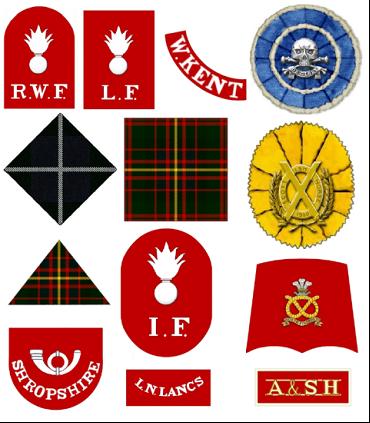
Some of the weird and wonderful shapes of helmet flashes often encountered on Foreign Service Helmets and Slouch Hats.
The British army has long used khaki coloured uniforms for its troops. This goes as far back as the Indian Mutiny and possibly before with some regiments of the East India Company’s army. The introduction and use of khaki into the British army is generally attributed to an army officer named W.S.R. Hodson, who later founded the irregular light cavalry, Hodson’s Horse.
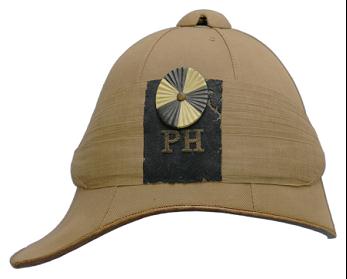
A magnificent Foreign Service Helmet (FSH) showing the helmet flash and roundel of Paget’s Horse. (Stuart Bates’ Collection)
During the first Anglo Boer War of 1880-81 many officers and men were killed as their bright red tunics made them very easy targets for Boer Sharpshooters. Consequently the adoption of khaki drill clothing in 1884 for troops in the Sudan was authorised. A khaki cover for the original white foreign service helmet was also adopted, although not always popular with many officers. Later this cover was replaced with foreign service helmets covered entirely in khaki material.
With the drab colour of their new uniforms, many regiments now found it hard to distinguish themselves from other regiments when on foreign service and so, many adopted a helmet flash as a means of identification and probably to a greater extent due to Esprit de Corps.
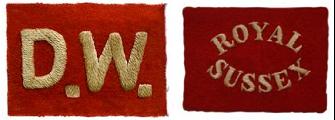
Two helmet flashes made from cut down epaulettes. The left one to the Duke of Wellington’s Regiment and the right to the Royal Sussex.
To the best of my knowledge, there is no standard army dress regulation as to the size or position where helmet flashes should be worn on the helmet during Victorian times. The decision of size, shape, position, colour and choice of material all appear to have been left to the individual regiment or corps.
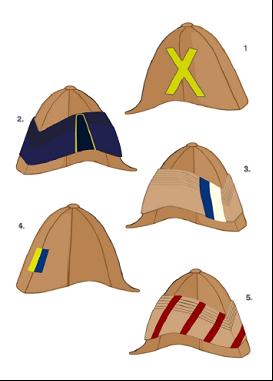
1. The Royal Scots Greys. (later version)
2. The Royal Horse Guards.
3. The 19th (Prince of Wales Own) Hussars.
4. The 18th Hussars.
5. The Royal Scots Greys (early version)
Victorian period photographs show helmet flashes being worn on the right, left, front and even both sides of Colonial and Wolseley helmets and in the case of the Gloucestershire Regiment additionally on the rear of the helmet in celebration of their victory at the Battle of Alexandria in 1801.
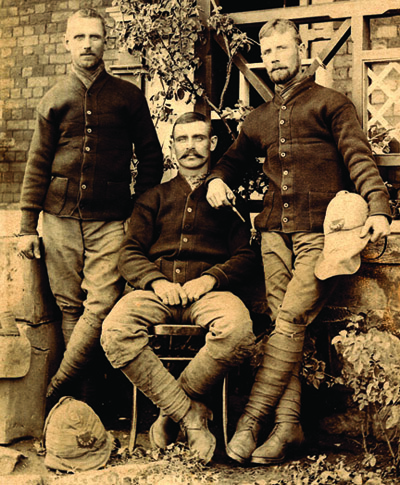
A remarkable photograph showing the Glosters flash to the front and the rear of the Foreign Service Helmet. (Photo courtesy of the Soldiers of Gloucestershire Museum)
Some Scottish regiments wore patches in the shape of a diamond, square or rectangular style cut from the tartan of their old clan affiliations. The Cameronians (Scottish Rifles) wore a diamond shaped piece of Douglas tartan worn on both sides of the helmet, this was adopted in 1892.
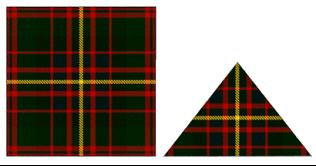
The Cameron Highlanders other ranks wore a square piece of Cameron of Erracht tartan on the left side, with officers additionally wearing a triangle of the same tartan on the rear of the helmet.
The Black Watch wore no patch at all, just a Red Hackle (feather) tucked into a fold of the puggaree. The regiment was awarded this distinction on the 4th of June 1795 for rescuing two field-pieces captured by the French at the battle of Guildermalson, January 1795.
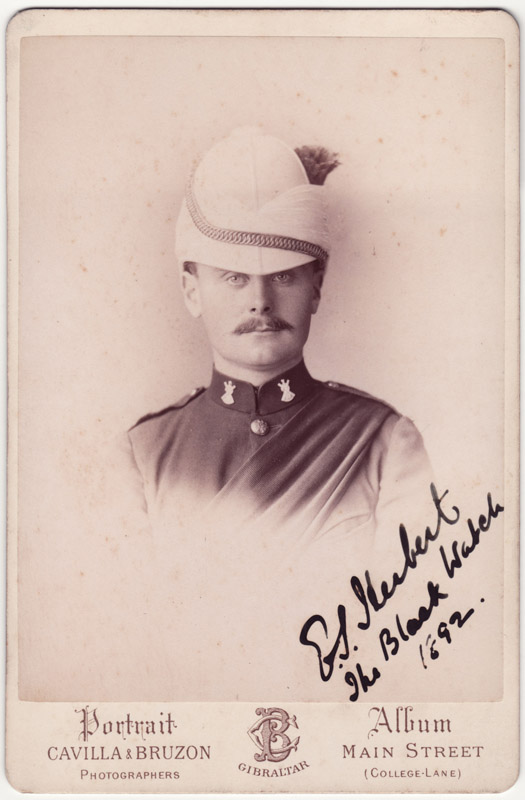
A splendid photo of a Black Watch (42nd Regiment) soldier showing the famous red hackle worn in the puggaree.
Some regiments wore fancy puggarees as a means of identification, the Royal Scots Greys, initially wore a red cloth wound through the puggaree, this was replaced by a large yellow cross on each side of the helmet in 1901.
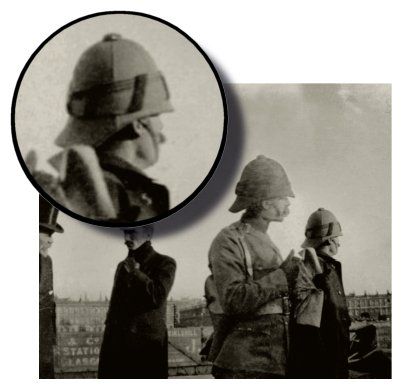
Royal Scots Greys’ officers departing for South Africa from Glasgow on board the S.S. Ranee. The intricate weave of the red cloth throughout the puggaree can be seen in this black & white photograph from 1899.
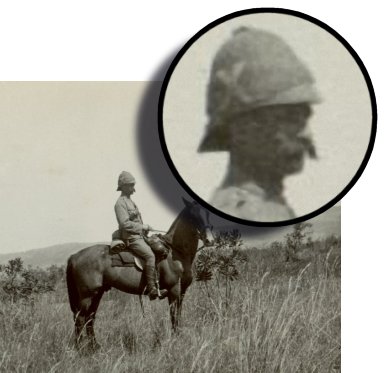
A Royal Scots Greys officer in South Africa wearing the later style patch about 1901. (Author’s collection)
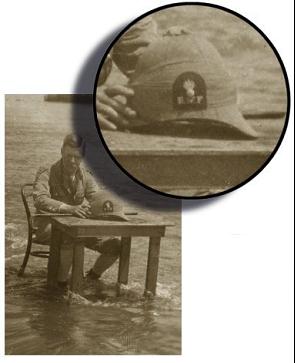
Shades of Monty Python in the Transvaal… A Royal Welsh Fusilier officer cooling off while sitting at a desk in a river. (Author’s collection)
Many patches simply display initials such as R.W.F. to denote Royal Welsh Fusiliers. Others used a combination of numbers and letters indicating the battalion and regiment, while yet other regiments displayed abbreviated names such as L.N.Lancs for Loyal North Lancashire regiment, or incorporated collar badges, shoulder titles and even glengarry badges.
Some helmet flashes were a little more intricate exhibiting embroidered regimental badges or honours such as these two. The left one shows a helmet flash of the North Staffordshire regiment and the right shows a flash of the Somerset Light Infantry (Prince Albert’s). Both are circa 1929 according to an article by John Mollo.
The use of helmet flashes on Foreign Service Helmets or even a painted logo on steel helmets to distinguish individual divisions or regiments has been used extensively throughout both world wars and continues into the modern day with some regiments of the army, as shown below in the helmet flash of the 1st battalion Royal Irish regiment. So the decision to cut up old epaulettes to aid identification in Victorian times is still very much alive and kicking over a hundred years later.
Benny Bough
Sources:
- The Oxford English Dictionary
- 1884 Health Exhib. Catal. 35/2 The new Khaki cloth, the material has been adopted by the War Office for the troops on active service. Note: “In India, khaki was used for uniforms by the Guide Corps under Lumsden and Hodson in 1848, by the troops in the Mutiny of 1857, in the Afghan campaigns of 1878–80, etc. It was worn in the Sudan Wars of 1883–98, and esp. by the British troops in South Africa in 1899–1902.
- Kidd, Ron, The Formation Sign, The Military Heraldry Society, FS 203-207, 209-210, 221-222, 229,232, Regimental Patches Worn during the South African War
- Knight, Ian with Embleton Gerry, The Boer War of 1899-02, Men-At-Arms #303
- Mollo, John, The Formation Sign, The Military Heraldry Society, FS 146-147, 149-152, 155, 158 Khaki Foreign Service helmet Embellishments, 1920-1940

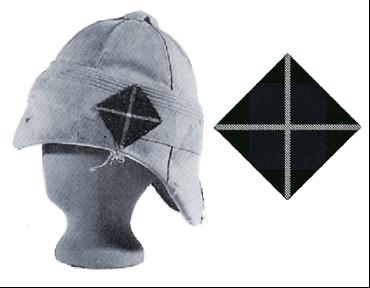
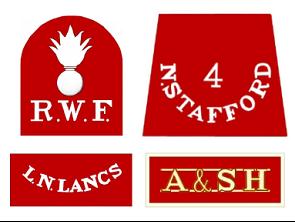
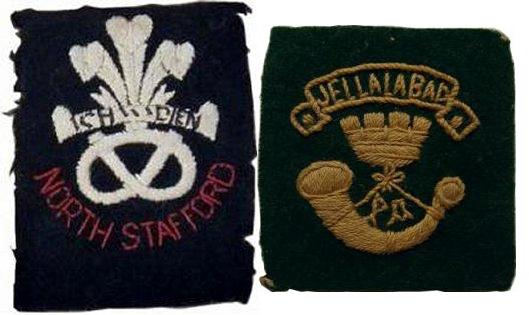
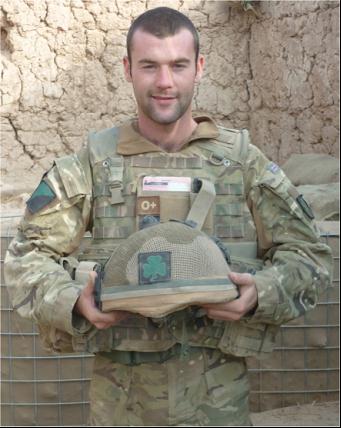
Excellent article with superb period photos. When can we expect a follow up?
Stuart
Superb information and pictures in an area of history I am quite fond of. Thanks for the presentation!
Always a very interesting topic!
As Hodson was with the Corps of Guides, Punjab Irregular Force, and the formation of what was to become Hodson’s Horse began in the Punjab in 1857, I would be interested to know if anybody has any original photos of the Guides in uniform, including helmets that date to 1857; Hodson’s particular regiment of cavalry was embodied as Hodson’s Horse before Delhi in 1857, and became 1st Hodson’s Horse in 1858.
I am intrigued by the Royal Horse Guards, 18th Hussars and 19th Hussars flashes illustrated. Can you tell me the sources for these as I have never come across these before.
Hi There, The source is an article by John Mollo in The Military Heraldry Society Magazine – published in magazines 203 – 207, 209 – 210, 221- 222, 229,232, where John Mollo wrote an extensive article on Helmet Flashes in the Boer War…hope that helps.
Sorry, that should be Ron Kidd, not John Mollo who wrote an extended article in the Formation Sign magazines 146-147, 149-152, 155, 158 called Khaki Foreign Service helmet Embellishments, 1920-1940
Very interesting
Hi Again.
Would like to know what would the rayol scots f pach would look like on the pith hat
Thankyou Shaun
The 1929 Clothing Reguations (India) give a cloth patch for the Royal Scots as comprising
a piece of regImental tartan 3″ x 2″. The tartan was Hunting Stewart, and photographs show the patch (on the left side of the helmet) to have been approx 3″x 3″ square and cut so that there were two thin diagonal stripes top left to bottom right in yellow, and top right to bottom left in red, on a dark green background. Both battalions of the regiment seem to have worn the same patch.
Hope that helps
Some very interesting examples and a particularly fine picture of the smart Royal Highlander with his Red Hackle. A small point in the context, perhaps, but worth stating nonetheless, the tradition that the Red Hackle originated as an award for the Regiment’s conduct during a French attack at Geldermalsen, although proving remarkably resilient, is now recognised as having little basis in fact.
On January 5th 1795, 2 light guns were captured by the French and then recovered, presumably by the Black Watch although no regiment was named, but there is no credible connection between that event and the assumption of red feathers by the Regiment later that year, as was believed in the 19th century.
There is evidence from a Black Watch veteran of the War of Independence that the Regiment were wearing red feathers in America as early as 1776. It would seem that after a lapse that custom was resumed in 1795 but as a purely regimental matter. Moreover the same veteran stated that the Regiment was granted the privilege of wearing ‘the red feather’ in 1802 on its return from Egypt after the battle of Alexandria. This followed the issue during their absence abroad of regulations ending the use of ornamental cap feathers chosen on a regimental basis.
Arguably the Black Watch ‘won’ the Red Hackle at Alexandria, even though they were already wearing it. King George’s permission, granted in 1802 but never recorded officially (we are told), converted the Regiment’s bonnet ornament into a distinction and was implicitly in recognition of their acclaimed contribution to the British victory the year before.
I would agree that there is some contention as to where the tradition of the Black Watch wearing the Red Hackle comes from, I even contacted the Regimental Museum at Balhousie Castle over the same question, even they could not give me a definitive answer, but suggested several sources as to where it may have been awarded, one being Geldermalsen, which for the purposes of the article i included.
True, there is continuing confusion amongst Black Watch circle as regards the Red Hackle. See Vol 1 of the official history ‘Highland Furies’ (Schofield, 2012). I think there is an element of denial, despite the game being up for the Geldermalsen story for at least thirty years, because it is hard to discard entirely a dramatic origin for such celebrated emblem. It’s easier to persist with the existing tradition than embrace a less tidy explanation, but a fashion with origins in America and then converted into a distinction after Alexandria is currently the best bet. It is an interesting topic since the hackle as we know it was first seen on the helmet designed for the Ashanti expedition in 1874 and as such may be the earliest example of a corps identification device on the sun helmet. Rgds.
Any idea what kind of thing the Buffs (Royal East Kent Regiment) would have worn? And also the Royal East Kent Mounted Rifles at the time?
The 2nd Battalion arrived in the cape in January 1900. The Battalion wore a white embroidered title on a square patch on the left side of the Foreign Service helmet. Photographs in the Regimental Museum show the patch worn with the Foreign Service Helmet (incidentally worn with a khaki neck curtain) but the wording is indistinct, i would assume either ‘BUFFS’ or ‘THE BUFFS’ as similar brass shoulder titles were introduced in
1898. With regards to the Royal East Kent Mounted Rifles, i have no information on them at all.
See if this works..
[IMG]http://i63.tinypic.com/2yyo3ev.jpg[/IMG]
http://i63.tinypic.com/2yyo3ev.jpg
heres a photo of the buffs in the Boer War ive uploaded to tinypic…the wording on the FS helmet is indistinct, but i would guess at just simply ‘Buffs’
http://i64.tinypic.com/261j4le.png
excelent insight in to various helmet insignia,can anyone confirm the slouch hat ribbon of blk,green,white stripes and a blk centre,with scots grys badge to the centre is indeed correct,many thanks
Had a look through my photograph album of the Greys in South Africa, they are only wearing the Colonial Style Pith Helmet in every photo, and either the large yellow cross on the side or the fancy pugaree versions, theres none like the flash you describe and no slouch hats. I would be interested to see it if anyone has a photo of them in slouch hats.
Cheers.
Hello I hope this site is still active I got an helmet that has on the inside of the liner an W written below is W arrow D I suppose war department . Below that is the number 17 . Is that an inspectors number or the year number 1917 Thnks for your help
Sorry it’s post World War One. WW1 issue equipment all have W arrow D with the number above the arrow, not below. the number is thought to refer to the inspector who passed the item of equipment fit for purpose in the Army and the letter is the clothing depot it was issued from.
Can anyone help me identify a helmet /uniform, picture taken between late 1910s and early 1920s. I assume its army of some sort.